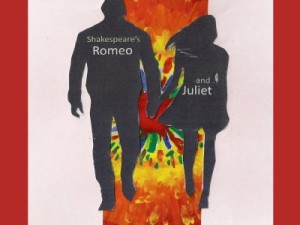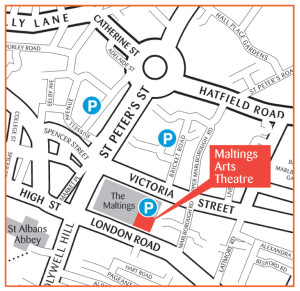“My passion was to produce a more artistic and accessible version of one of Shakespeare’s finest and most heartfelt plays. Romeo in my version is a student, which was inspired by his line in Act 2, Scene 2: ‘A thousand times the worse to want thy light. Love goes toward love as schoolboys from their books, but love from love, toward school with heavy looks.’ I also wanted a more innocent setting for the star-crossed lovers, so our show has a flavour of the black and white designs of the 1960s and Prokofiev’s Romeo and Juliet score.”
So says director Paula Chitty of her production of Romeo and Juliet, performed at the Maltings Theatre, St Albans. She is actually being modest, since this is, in its own way, a deliberately and self-consciously innovative production.
It is not the first production in which the action has commenced in the foyer/bar of a theatre, but effectively conducts much of the party scene during the first interval, employing the audience as extras. Indeed, Romeo also advances into the audience to address the apothecary in the lighting booth at the rear of the auditorium, using the compact space available to the full.
The party is one of few scenes where splashes of colour are used, with masks and reversible cloaks. Back in the theatre, the theme is very definitely black and white, notably in the costumes employed by the Montagues (white) and Capulets (black), set and many props. I note from the programme that Ms Chitty was responsible both for design and costumes, in addition to directing and co-producing.
The set is simple, consisting of a white stylised tree (behind which Romeo lurks in the early part of the balcony scene) and a raised platform at each end of the stage (over which one character nearly fell, much to the hilarity of the audience.) There are also two tables and a number of chairs, all of which are configured according to the scene (eg. upside down adorning candles for the lovers’ death scene.) Not an over-busy set, in-keeping with the current trend of minimalising Shakespeare, all the better to focus on the words and their meaning.
Also in-keeping with current practice the script is pared down, though not as harshly as some: this Romeo & Juliet began about 18:10 and finished at 20:45 – thankfully no chorus, for example. Surviving the editing process, some of the fine speeches are left more or less intact in their beautiful language, though I will confess my impaired hearing meant I struggled to hear some of those glorious words, possibly a reflection on the acoustics of the theatre given that the clarity was markedly better for scenes conducted in the foyer – but then other factors were also afoot…
What surprised me most was the way the production not so much as defies as thumbs its nose at theatrical convention. On many occasions, actors turn their backs to the audience, and with some frequency talk while facing upstage. Action is often taking place on the dark side of the stage while a scene takes place on the light side. I’m all for challenging the orthodox and finding new ways to stage scenes, but this distraction did not help my concentration, especially since it’s difficult to hear actors when you can’t see them speak. This style may work when used sparingly, but Ms Chitty was in my view a tad heavy handed.
To focus on her successes, she promised us a more artistic and accessible production, and that is indeed what we got. “Did my heart love till now? Forswear it, sight! For I ne’er saw true beauty till this night” says Romeo in Act 1 Scene 5, and this quote is adopted as the production catchphrase and philosophy.
The cast rose to the challenge and did a fine job of clarifying the motives of each character, providing some insight to the long-running feud between the Montagues and the Capulets, and the emotions resulting from one member of each dynasty falling for the other. They also master iambic pentameter, and as I know from my own dealings it can be mighty tricky to wrap your tongue around the words while keeping rhythm.
I was particularly impressed with Trevor D Oakes’s Capulet, a generous host and an authoritarian bully in equal measure; and Anna Franklin’s nurse, successfully bringing out the humour of the key role of messenger between the lovers, the go-between. Vince McLoughlin’s Tybalt reminded me in strong measure of James Caan’s Sonny in The Godfather, an ambitious hothead and a contrast to his other role as a gentle and mournful Count Paris.
Also worthy of note are John Stivey’s Benvolio and Warren Albers’s Mercutio, responsible as a pair for the knockabout humour and joshing over their moonstruck comrade Romeo’s furtive love affair, and thereby performing a similar role as, say, Falstaff to Prince Hal.
But what of the star cross’d lovers? Both Rob Ferguson and Philippa Lawford look the part, being young and attractive. That they would fall in love is entirely credible, and to give each credit their overwhelming passion rises to an unquenchable crescendo. Heart very definitely overrules head, apart from the scene where Juliet employs deceit in apologising to her father and promising to go ahead with the arranged marriage to Paris.
Ms Lawford decidedly takes the acting honours through her transformation from a gay (old meaning) and giggling schoolgirl to an impassioned, tragic lover and heroine, taking her own life over the tragic misunderstanding that saw Romeo take his. Her depth of feeling is never in doubt, none more so than when she says: “I have a faint cold fear thrills through my veins/That almost freezes up the heat of life” and, sure enough, the blood chilled in my veins.
The production identifies as its primary theme the obtuse failings in men’s hearts caused by their inability to see and accept love in the purest sense, and the tragedy that results is a direct result of that failing. In delivering the message this production achieves both clarity and passion, for which it deserves both admiration and praise.




Nice to read your review which I fell upon this morning while on the train.
I thought you might be interested to know that the production was originally designed in traverse , but due to the smaller audience attendance at some of the performances the far seats were removed so not to detract . This is no doubt why some of the actors turned towards the
The black and white to colour , was symbolic of the divide between the two families. As the couple meet and fall in love and unite the sides there is the introduction of colour , a brightening of their worlds . The black and white returns slowly as things start to go wrong. The last changes from colour,Lady Capulet’s blood red skirt , the only colour in an itherwise black and white scene where both Tybalt and Mercitio are found dead and the change of the colour flowers and altercloth to black and white during Paris’ last speech and ending back in black and white as the couple die.
Many Thanks for the review and entertaining my trip into London. Look forward to reading up on other shows you have been to see.
Many thanks for your reply, and I can indeed see your rationale! As an amateur actor who has done Shakespeare, it was a joy and a pleasure to see your production. Hope to see more in future 🙂
Wohh ちょうど私は探しされたもののために、ためによろしく 投稿。 主題トピックこれで| 心配興味私は常にあった